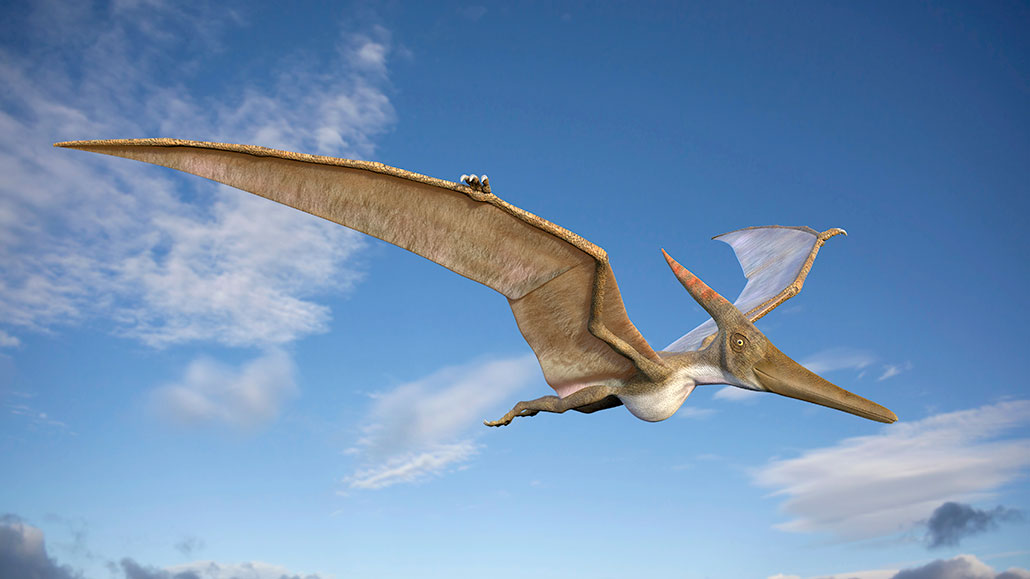Let’s learn about pterosaurs
These ancient flying reptiles were close relatives to dinosaurs

Pterosaurs like this pteranodon (illustrated) soared through the skies while their dinosaur cousins walked the Earth below.
ROGER HARRIS/SCIENCE PHOTO LIBRARY/Getty Images
Share this:
- Share via email (Opens in new window) Email
- Click to share on Facebook (Opens in new window) Facebook
- Click to share on X (Opens in new window) X
- Click to share on Pinterest (Opens in new window) Pinterest
- Click to share on Reddit (Opens in new window) Reddit
- Share to Google Classroom (Opens in new window) Google Classroom
- Click to print (Opens in new window) Print
Pterosaurs may have been the closest thing Earth ever had to dragons.
These flying reptiles ruled the skies during the age of the dinosaurs. They weren’t dinosaurs themselves. But pterosaurs did share a common ancestor with dinos. These flyers emerged over 200 million years ago. And they thrived until about 66 million years ago, dying out along with the dinosaurs.
Pterosaurs were a diverse group of beasts that made their home on every continent. Perhaps the best known was the pterodactyl. This was the first pterosaur species discovered, back in 1784. Since then, hundreds of other species have been unearthed. Some were as small as bats. Others were as big as fighter jets. Pterosaurs are thought to be the first vertebrates to fly. (Invertebrate insects took to the air first.) Hollow bones were probably key to getting even the biggest pterosaurs off the ground.
But pterosaurs’ fragile skeletons have also made them difficult to study. Their bones have not preserved as well as those of dinosaurs. So, there aren’t as many pterosaur fossils to study. But existing fossils have revealed surprising details about these flying reptiles.
For instance, pterosaurs — like dinosaurs — probably had feathers, or at least featherlike fuzz. Unlike most modern birds, pterosaur hatchlings may have been born ready to fly. And one pterosaur nicknamed Monkeydactyl might be the oldest known creature with opposable thumbs.
Dinosaurs may have stolen most of the prehistoric spotlight so far. But pterosaurs may deserve just as much fascination. Here, there be dragons.
Want to know more? We’ve got some stories to get you started:
Bright-colored feathers may have topped pterosaurs’ heads Fossil remains of a flying reptile hint that their vibrant crests may have originated 250 million years ago in a common ancestor with dinosaurs. (6/17/2022) Readability: 7.7
Sprinting reptiles may have been forerunners of soaring pterosaurs A new analysis of an old fossil supports the idea that winged pterosaurs evolved from swift and tiny two-legged ancestors. (12/12/2022) Readability: 7.5
Baby pterosaurs may have been able to fly right after hatching A bone crucial for lift-off was stronger in hatchling pterosaurs than in adults. The baby reptiles also had shorter, broader wings than grown-ups. (9/15/2021) Readability: 7.3
Explore more
Explainer: The age of dinosaurs
Let’s learn about dinosaurs’ fearsome neighbors
Warm feathers may have helped dinos survive mass Triassic die-off
Mini pterosaur from the age of flying giants
Jackpot! Hundreds of fossilized pterosaur eggs unearthed in China
These fuzz-covered flying reptiles had catlike whiskers
How to build your dragon — with science
Activities
Download and print Pterosaurs: A Card Game from the American Museum of Natural History. The game, based on the museum’s collections and exhibits, challenges players to gain points by building their own food chains and breaking their opponent’s.







